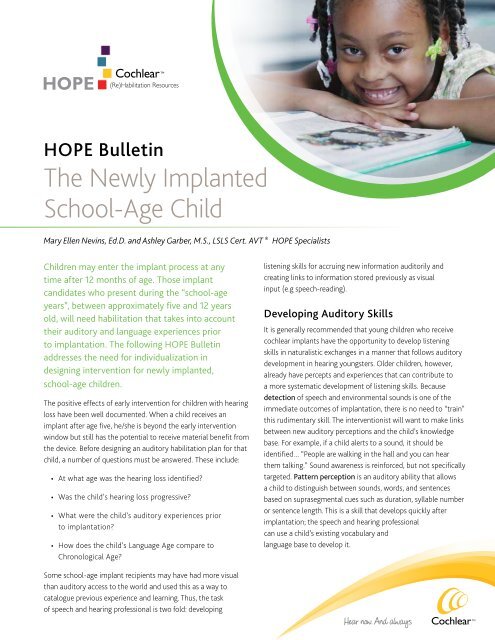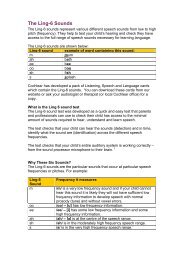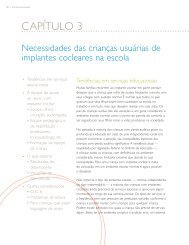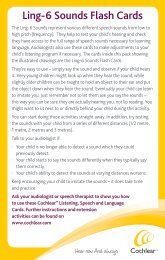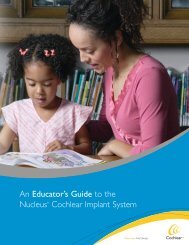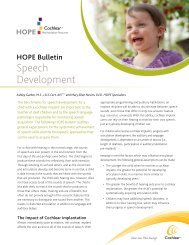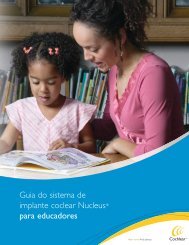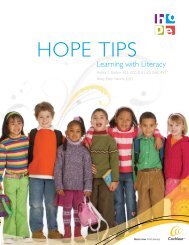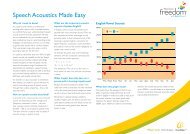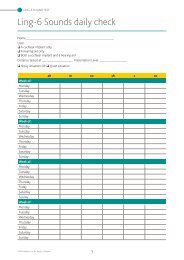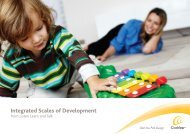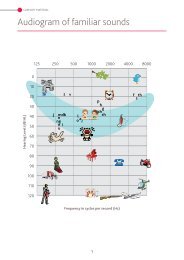The Newly Implanted School-Age Child - Cochlear
The Newly Implanted School-Age Child - Cochlear
The Newly Implanted School-Age Child - Cochlear
You also want an ePaper? Increase the reach of your titles
YUMPU automatically turns print PDFs into web optimized ePapers that Google loves.
HOPE Bulletin<br />
<strong>The</strong> <strong>Newly</strong> <strong>Implanted</strong><br />
<strong>School</strong>-<strong>Age</strong> <strong>Child</strong><br />
Mary Ellen Nevins, Ed.D. and Ashley Garber, M.S., LSLS Cert. AVT ® HOPE Specialists<br />
<strong>Child</strong>ren may enter the implant process at any<br />
time after 12 months of age. Those implant<br />
candidates who present during the “school-age<br />
years”, between approximately five and 12 years<br />
old, will need habilitation that takes into account<br />
their auditory and language experiences prior<br />
to implantation. <strong>The</strong> following HOPE Bulletin<br />
addresses the need for individualization in<br />
designing intervention for newly implanted,<br />
school-age children.<br />
<strong>The</strong> positive effects of early intervention for children with hearing<br />
loss have been well documented. When a child receives an<br />
implant after age five, he/she is beyond the early intervention<br />
window but still has the potential to receive material benefit from<br />
the device. Before designing an auditory habilitation plan for that<br />
child, a number of questions must be answered. <strong>The</strong>se include:<br />
• At what age was the hearing loss identified?<br />
• Was the child’s hearing loss progressive?<br />
• What were the child’s auditory experiences prior<br />
to implantation?<br />
• How does the child’s Language <strong>Age</strong> compare to<br />
Chronological <strong>Age</strong>?<br />
listening skills for accruing new information auditorily and<br />
creating links to information stored previously as visual<br />
input (e.g speech-reading).<br />
Developing Auditory Skills<br />
It is generally recommended that young children who receive<br />
cochlear implants have the opportunity to develop listening<br />
skills in naturalistic exchanges in a manner that follows auditory<br />
development in hearing youngsters. Older children, however,<br />
already have percepts and experiences that can contribute to<br />
a more systematic development of listening skills. Because<br />
detection of speech and environmental sounds is one of the<br />
immediate outcomes of implantation, there is no need to “train”<br />
this rudimentary skill. <strong>The</strong> interventionist will want to make links<br />
between new auditory perceptions and the child’s knowledge<br />
base. For example, if a child alerts to a sound, it should be<br />
identified... “People are walking in the hall and you can hear<br />
them talking.” Sound awareness is reinforced, but not specifically<br />
targeted. Pattern perception is an auditory ability that allows<br />
a child to distinguish between sounds, words, and sentences<br />
based on suprasegmental cues such as duration, syllable number<br />
or sentence length. This is a skill that develops quickly after<br />
implantation; the speech and hearing professional<br />
can use a child’s existing vocabulary and<br />
language base to develop it.<br />
Some school-age implant recipients may have had more visual<br />
than auditory access to the world and used this as a way to<br />
catalogue previous experience and learning. Thus, the task<br />
of speech and hearing professional is two fold: developing
<strong>Age</strong> appropriate listening games and activities are recommended<br />
for pattern perception especially when content or theme-based<br />
classroom materials are incorporated.<br />
<strong>The</strong> auditory skill of segmental identification requires that<br />
the child hear more than patterns of sounds. It is often the<br />
powerful vowel sounds that a child begins to attend to in<br />
order to differentiate between the words “backpack” and<br />
“lunchbox.” Familiar vocabulary usage is particularly “friendly”<br />
when introducing and practicing this skill with the newly<br />
implanted school-aged child. <strong>Child</strong>ren at the level of segmental<br />
identification may spend some time working within these two<br />
levels of auditory skill, especially as language complexity and<br />
familiarity is manipulated within a skill level.<br />
<strong>The</strong> highest level of auditory skill, auditory comprehension,<br />
requires that the child process and respond to information<br />
presented through listening only. <strong>Child</strong>ren, who respond to<br />
auditory input once access is provided by the implant,<br />
should be encouraged to use listening for comprehension.<br />
This may first be expected in routine situations in which the<br />
context and form of the language are known to the child.<br />
Encouragement for functional listening at all levels of<br />
auditory skill development will serve to reinforce the utility<br />
of listening in gaining information about the world.<br />
Creating Links to Information<br />
Acquired Prior to Implantation<br />
<strong>The</strong> school-based professional will not want to overlook the<br />
store of world and language knowledge that the child acquired<br />
before implantation. While it is not recommended that<br />
systematic transfer of visual language and world knowledge<br />
to an auditory representation be undertaken, there is utility<br />
in helping create listening links to previously acquired speech,<br />
language and world knowledge. This may be best accomplished<br />
in one-on-one intervention settings; new auditory skills can be<br />
developed and practiced in the context of familiar vocabulary,<br />
language and content. Conversely, acquired auditory skills<br />
may be practiced when introducing new themes. As the child<br />
becomes successful, generalizations to information gathering<br />
through audition may be facilitated.<br />
High, but Realistic, Expectations<br />
<strong>The</strong> single most important goal for the school-based professional<br />
working with a newly implanted school-age child is to foster<br />
feelings of success with the device. Since early accomplishment<br />
begets later success, it is incumbent upon the interventionist<br />
to design activities and tasks that will allow the child to realize<br />
auditory benefit from the implant at any of the skill levels at<br />
which the journey begins. <strong>The</strong> knowledgeable professional should<br />
set realistic expectations, but at the same time, be open to<br />
reaching greater levels of performance for a child in light of the<br />
new auditory access afforded by cochlear implant technology.<br />
Related Resources<br />
Chute, P., & Nevins, M.E. (2006). <strong>School</strong> Professionals Working with<br />
<strong>Child</strong>ren with <strong>Cochlear</strong> Implants. San Diego: Plural Publications.<br />
<strong>Cochlear</strong> Americas (2009). Sound and WAY Beyond.<br />
To order, visit <strong>Cochlear</strong>Americas.com/Store or call<br />
Customer Service at 800 523 5798.<br />
<strong>Cochlear</strong> Americas. (2003). Listen Learn and Talk, Tape 3:<br />
“<strong>Child</strong>ren Chatter”. Englewood, CO. To order, visit the HOPE<br />
Education and Rehab section of the <strong>Cochlear</strong> Online Store:<br />
www.<strong>Cochlear</strong>Americas.com/Store or watch online at:<br />
www.<strong>Cochlear</strong>Americas.com/HOPE<br />
DeConde Johnson, C., Benson, P., & Seaton, J. (1997). Educational<br />
Audiology Handbook. Florence KY: Thomson Delmar Learning.<br />
Johnson C (2011), Preparing Students to be Successful in their<br />
Learning Environments, HOPE Online Learning Library,<br />
www.<strong>Cochlear</strong>Americas.com/HOPE<br />
Nevins, M.E., & Chute, P.C. (1996). <strong>Child</strong>ren with <strong>Cochlear</strong><br />
Implants in Educational Settings. San Diego: Delmar.<br />
Nevins, M.E., & Garber, A.S. (2005). CLIC IT ! Creating<br />
Listeners in the Classroom. HOPE Online Library. Available<br />
at www.<strong>Cochlear</strong>Americas.com/HOPE<br />
Robbins, A.M. (2000). “Rehabilitation after <strong>Cochlear</strong><br />
Implantation,” in J.K. Niparko (Ed.) <strong>Cochlear</strong> Implants:<br />
Principles and Practices. (pp. 323-362). Philadelphia.<br />
Lippincott, Williams & Wilkins.<br />
Sorkin, D.S. (2005). <strong>Child</strong>ren and <strong>Cochlear</strong> Implants: What <strong>The</strong>y<br />
Need at <strong>School</strong>. HOPE Online Seminar. Available at<br />
www.<strong>Cochlear</strong>Americas.com/HOPE<br />
<strong>Cochlear</strong> Americas<br />
13059 East Peakview Avenue<br />
Centennial, CO 80111<br />
1 800 523 5798<br />
<strong>Cochlear</strong> and the elliptical logo are trademarks of <strong>Cochlear</strong> Limited.<br />
FUN659 ISS5 DEC10<br />
www.<strong>Cochlear</strong>Americas.com/HOPE


